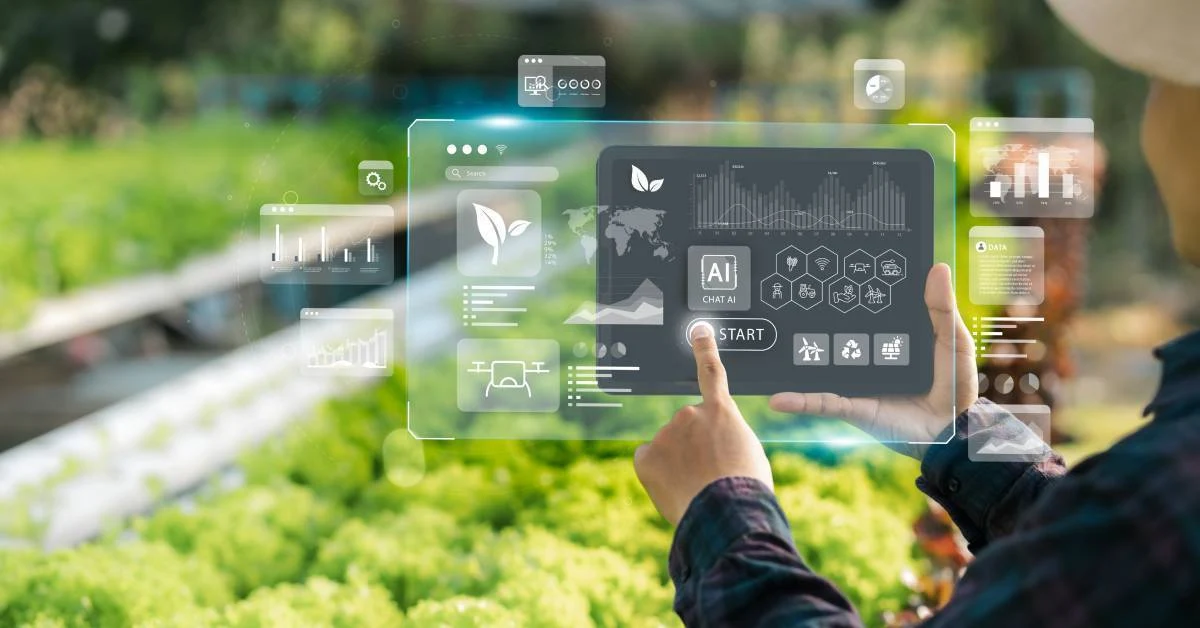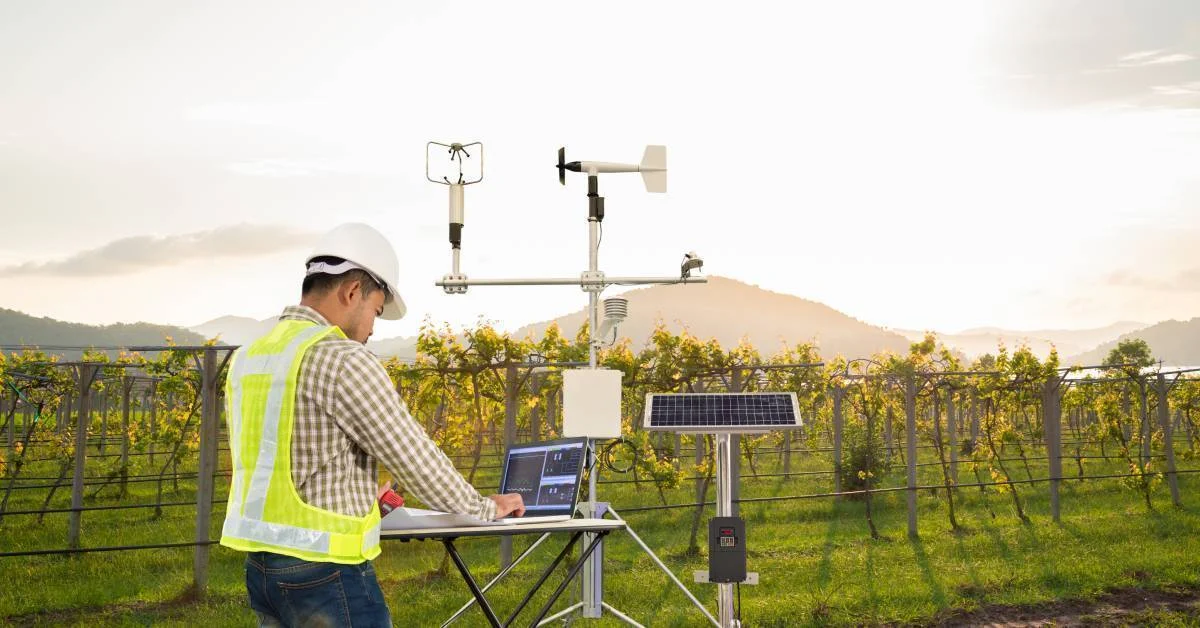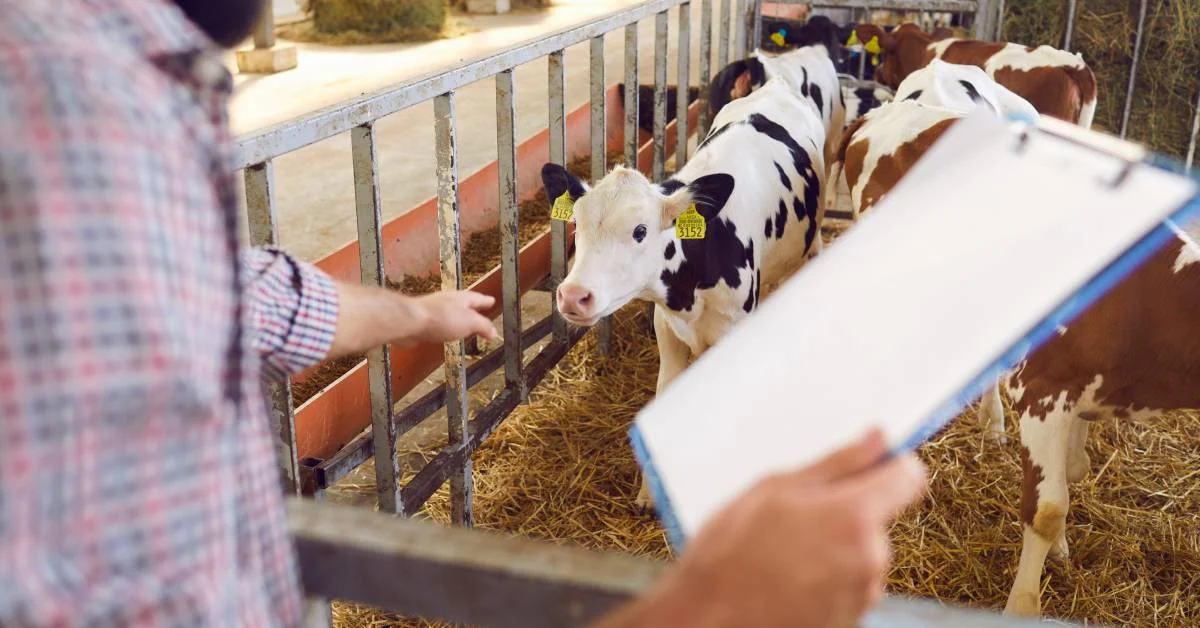The agricultural industry has witnessed significant technological shifts in recent years to address its mounting challenges. From climate change and labor shortages to the increasing demand for food, farmers worldwide are leaning into technology to overcome these obstacles.
The year 2025 will have seen numerous advancements in technology in agriculture, transforming traditional farming practices into a high-tech enterprise. As we explore the role of technology in agriculture today, we’ll examine how innovations such as artificial intelligence, robotics, IoT, and blockchain have become game-changers, enhancing productivity and sustainability.
So, let’s delve into these developments and understand their implications for farmers, consumers, and the agricultural landscape.
The Need for Technological Advancements in Agriculture
Several pressing issues drive the urgent need for advanced technology in the agriculture industry. These challenges, from increased food demand to climate change and labor shortages, highlight the necessity for innovation to sustain global food production effectively.
Growing Demand and Limited Resources
With the global population on a continuous rise, the demand for food has reached unprecedented levels, pushing the agricultural sector to produce more with fewer resources. Farmers now face the daunting task of maximizing output despite resource constraints like arable land and water. Here, farming technology in agriculture offers invaluable solutions to optimize yield and efficiency, making it possible to meet rising demands without depleting natural resources.
Climate Change Pressures
Agriculture is at the forefront of the climate crisis, with unpredictable weather patterns, extreme temperatures, and shifting growing seasons disrupting crop production. Climate change has become a formidable challenge for farmers, affecting crop health and yield consistency.
However, new farming technology provides ways to adapt. Predictive analytics, climate-resistant crop varieties, and data-driven insights enable farmers to employ sustainable practices, helping mitigate the impacts of climate change on agriculture.
Labor Shortages
The agricultural industry has long grappled with labor challenges, but labor shortages have become even more pronounced in recent years. This scarcity strains operations, especially during critical periods like planting and harvesting.
Technology in agriculture, particularly automation and robotics, offers solutions to address these shortages. Farmers can optimize operations and maintain productivity even with a reduced workforce by incorporating automation into repetitive, labor-intensive tasks.
Major Technological Innovations Impacting Agriculture in 2025
In 2025, technology in agriculture will reach new levels of efficiency and sustainability thanks to a suite of groundbreaking technological innovations. These advancements empower farmers to work smarter, address global challenges, and enhance food production while conserving resources.
Precision Agriculture
Definition and Benefits
Precision agriculture is a transformative approach that uses GPS technology, sensors, and data analytics to monitor and manage crops at a highly detailed level. This technology in agriculture allows farmers to make precise watering, fertilizing, and harvesting decisions, minimizing waste and optimizing yield. With data-driven insights, precision agriculture enables sustainable practices that conserve resources and reduce environmental impact, all while increasing productivity and profitability.
Technologies Involved
The key technologies powering precision agriculture include satellite imagery, soil sensors, and drones. Together, they offer real-time data on crop health, soil moisture, and nutrient levels, which can be analyzed to guide effective farming practices.
Drones and remote sensors, for example, help identify potential issues early, such as pest infestations or nutrient deficiencies, allowing for quick intervention and improved crop health. Software developers play a crucial role in creating applications and platforms to process, analyze, and visualize this data, ensuring that insights are easily accessible for informed decision-making. CRM systems like Salesforce are essential for processing, analyzing, and visualizing data from precision agriculture tools. This integration provides a centralized hub for managing customer relationships and delivering targeted solutions.
Practical Examples
In 2025, precision agriculture tools became widely accessible, making this approach more mainstream. For instance, Variable Rate Application (VRA) systems are now commonly used to adjust fertilizer and pesticide distribution according to the unique needs of different field areas.
Farmers can target specific field sections with these systems, saving on input costs and enhancing productivity by ensuring that resources are applied only where they’re most needed. Many of these tools now provide data export features, allowing results to be saved in multiple formats, including Office 2024, so farmers and agronomists can easily analyze trends, create reports, and share insights with stakeholders. This precise management improves crop yields, cuts costs, and promotes sustainable farming practices by reducing chemical runoff and soil depletion.
Artificial Intelligence and Machine Learning
Applications
Artificial Intelligence (AI) and Machine Learning (ML) are reshaping agriculture by turning vast data into actionable insights. These technologies are critical in predicting crop diseases, analyzing weather patterns, optimizing planting and harvesting schedules, and managing supply chains. Custom AI solutions help to reach measurable and predictable results by analyzing multiple factors that affect yields.
Benefits
- Integrating AI and ML into agriculture has substantial benefits. Real-time insights enable farmers to increase productivity, lower operational costs, and improve resource efficiency.
- Precisely targeting issues, such as pest infestations or crop diseases, also reduces environmental impact, making AI-driven solutions a key player in sustainable farming.
- As AI tools evolve, they continue to provide farmers with a competitive edge by enhancing profitability and promoting practices that protect the environment, ensuring the long-term viability of agriculture.
Robotics and Automation
Trends in 2025
Robotics and automation technologies have gained remarkable traction in agriculture in 2025. Autonomous machinery such as robotic weeders, automated planters, and driverless tractors are now standard on farms, performing repetitive and physically demanding tasks with impressive precision.
In greenhouse settings, robots handle labor-intensive tasks like pruning and planting, while drones survey fields and pollinate plants. As these technologies continue to evolve, they’re proving indispensable for large-scale agricultural operations and are beginning to see increased adoption on mid-sized farms.
Impact on Labor and Efficiency
Automation is transforming labor dynamics in agriculture. Reducing the need for manual labor is especially beneficial in regions with acute labor shortages. Robots can execute tasks such as planting, pruning, and harvesting much faster than human labor, ensuring timely completion of work during critical growing and harvesting periods.
Challenges
Despite the significant advantages, high initial costs and ongoing maintenance needs present barriers to the widespread adoption of robotics. Smaller farms often find it financially challenging to invest in advanced machinery.
Drones in Agriculture
Current Uses
Drones have become essential in agriculture, providing aerial insights that are otherwise hard to obtain. From monitoring crop health and analyzing soil conditions to surveying large tracts of farmland, drones in agriculture offer a comprehensive view that enables early detection of issues like pest infestations, nutrient deficiencies, and irrigation inefficiencies. Their ability to capture real-time imagery helps farmers make informed decisions quickly, minimizing crop losses and optimizing yields.
Latest Innovations
In 2025, drones will have advanced with multi-spectral sensors and AI capabilities that enhance their monitoring potential. These drones can capture data across different spectral bands, allowing for precise plant health, soil moisture, and crop maturity analysis. Equipped with AI, they can automatically identify problem areas, such as diseased plants, and alert farmers to take immediate action. This level of sophistication enables quicker response times, making drones an invaluable tool for proactive crop management.
Advantages and Limitations
Drones bring several benefits, including reduced need for ground inspections, enhanced crop management, and efficient resource utilization. However, they face limitations, particularly with regulatory restrictions on airspace and requiring skilled operators to manage flights and analyze data. These factors can make drone operations challenging for smaller farms without the resources to train staff or navigate regulatory landscapes effectively.
IoT and Smart Farming Solutions
IoT Integration
The integration of the Internet of Things (IoT) in agriculture connects many sensors and devices that continuously collect data on soil conditions, moisture levels, weather patterns, and equipment status.
These sensors feed data into centralized farm management systems, enabling farmers to make real-time adjustments and gain greater control over every aspect of the farm. The resulting network provides unprecedented operational insight, enabling decisions that improve crop health and resource allocation.
Data Analytics in Real-Time
IoT-driven farms leverage real-time agriculture data analytics to monitor and adjust environmental conditions, ensuring optimal crop growth. For example, sensors can detect soil moisture levels and trigger irrigation systems only when necessary, reducing water wastage and improving crop yields. IoT services for the agriculture sector are making this level of precision and automation increasingly accessible to modern farmers.
Blockchain for Supply Chain Transparency
Applications in 2025
Blockchain technology in agriculture has become a powerful tool for enhancing transparency and trust across the agricultural supply chain. In 2025, farmers, suppliers, and retailers are increasingly utilizing blockchain to provide detailed, tamper-proof records of product journeys from farm to market.
Consumer Trust
As consumer demand for visibility into food sourcing grows, blockchain technology in agriculture has become instrumental in building trust. In 2025, consumers are keenly interested in knowing where their food comes from, how it was grown, and under what conditions.
Blockchain Examples
Several platforms, like IBM Food Trust, are making strides in traceability for agriculture by enabling secure, shared ledgers where every transaction and movement in the supply chain is recorded. Farmers using such platforms can log essential data about each stage of the agricultural process, from planting to harvest to distribution. This helps build a transparent “farm-to-fork” journey that enhances consumer confidence and opens new markets for traceable, verified products.
Genetic Engineering and CRISPR
Advancements in 2025
Genetic engineering, particularly CRISPR (Clustered Regularly Interspaced Short Palindromic Repeats), has made significant strides in agriculture in 2025. Genetic advancements are creating crops that can thrive in challenging conditions, helping farmers mitigate the risks of climate change and environmental pressures.
CRISPR and Beyond
In 2025, CRISPR technology in agriculture will not only enhance crop resilience but also improve the nutritional profile of certain crops, increase yields, and extend shelf life. These genetic modifications allow for a more efficient and sustainable food system, as fewer resources are needed for crops to thrive in adverse conditions.
Beyond CRISPR, new gene-editing tools are emerging, offering even greater potential for innovation in creating more resilient and resource-efficient food supplies.
Ethical Considerations
While genetic engineering offers immense potential, it raises important ethical considerations. Questions around GMO labeling, long-term environmental impact, and biodiversity preservation remain at the forefront.
Advocates for transparency argue that consumers have the right to know if their food is genetically modified, while others express concerns over the ecological effects of widespread genetic modifications.
Benefits of Technological Advancements in Agriculture
As agriculture embraces modern technology in agriculture, the benefits for farmers, the environment, and food production have become increasingly clear. These innovations support farmers in achieving higher efficiency and profitability and promote environmental stewardship, helping to responsibly meet rising global food demands.
1. Higher Yields
Modern agricultural technologies empower farmers to achieve higher yields by using resources more efficiently and minimizing waste. Precision farming tools, such as soil sensors, GPS-guided equipment, and data analytics, enable farmers to monitor and address crop needs accurately.
This targeted approach helps maximize productivity, ensuring crops receive the proper water, nutrients, and care. Ultimately, these advancements contribute to increased food production, helping to meet global food demands efficiently and sustainably.
2. Environmental Benefits
As agriculture seeks to minimize its environmental impact, technology in agriculture is vital in promoting sustainable practices. Tools like precision irrigation systems, drones, and automated pest control reduce the need for excessive water, chemical fertilizers, and pesticides, lowering greenhouse gas emissions and preserving local ecosystems.
Additionally, technology in agriculture helps farmers conserve resources by using only what is necessary, allowing agriculture to become more environmentally responsible and supporting long-term ecological health.
3. Economic Benefits for Farmers
Technological advancements translate into tangible economic gains for farmers. By automating labor-intensive tasks, optimizing input use, and improving crop quality, farmers can reduce operational costs and boost profits.
Technologies like IoT sensors, robotic systems, and data-driven decision-making tools enable farmers to save on resources, reduce waste, and minimize losses from crop failure. This increased efficiency makes farming a more profitable and viable livelihood, especially for small-scale farmers looking to compete in a challenging market.
Challenges of Adopting Technology in Agriculture
While technology in agriculture has the potential to revolutionize agriculture, its adoption has challenges. For many farmers, implementing advanced tools and systems can be challenging due to high initial costs, a steep learning curve, and limited access to technical support.
Furthermore, concerns around data privacy and regulatory hurdles add layers of complexity. Addressing these challenges is essential to ensure that technological benefits reach farmers of all scales and regions, enabling a more inclusive approach to modern agriculture.
1. Cost Barriers
High upfront costs remain a significant hurdle, particularly for small and medium-sized farms that need more capital to invest in advanced technology in agriculture.
2. Technical Knowledge Gap
The rapid pace of technological advancement has created a skills gap in agriculture. Farmers need training to adopt and use these new tools effectively.
3. Data Privacy Concerns
As farms collect vast amounts of data, concerns about data privacy and security have grown, prompting a need for clear policies and safeguards.
4. Regulatory Hurdles
In many regions, regulatory frameworks are yet to catch up with technological advancements, slowing down adoption and innovation in agriculture.
The Future of Technology in Agriculture Beyond 2025
As we look beyond 2025, the future of technology in agriculture holds exciting possibilities. Innovations in AI, genetic engineering, and robotics are expected to continue transforming the industry, pushing the boundaries of what’s possible in food production.
Sustainable practices and climate-resilient farming will likely become the norm as environmental concerns drive change. This section explores the anticipated trends and long-term impacts of emerging technologies on global food security, aiming to provide a glimpse into a future where agriculture is more efficient, resilient, and sustainable.
Predicted Trends
Future innovations may include enhanced AI capabilities, improved climate-resilient crops, and more widespread use of blockchain for end-to-end transparency.
Long-term Impact on Global Food Security
As technology in agriculture evolves, it will play a pivotal role in ensuring food security for future generations, making agriculture more resilient and efficient.
Sustainable Agriculture Focus
Technological advancements will increasingly focus on sustainability, supporting practices that reduce environmental impact while enhancing productivity.
How Farmers Can Prepare for the Future
With rapid advancements in technology in agriculture, farmers must stay proactive in preparing for the future. Education and training will be crucial in helping them adopt new tools and techniques effectively. Government and private sector support and collaborative initiatives can also play a key role in making technology in agriculture accessible to all farmers.
This section offers practical strategies for farmers to keep pace with technological change, enhancing their resilience and readiness for the evolving agricultural landscape.
Education and Training
Farmers can benefit from targeted training programs to develop the skills to manage new technology in agriculture and optimize their operations.
Government and Private Initiatives
Support from government programs and private initiatives can make advanced technology in agriculture more accessible to farmers, leveling the playing field.
Collaborative Models
Collaborative models that connect farmers with tech providers, research institutions, and policy-makers can drive the adoption of sustainable and impactful technology in agriculture solutions.
Conclusion
The advancements in technology in agriculture in 2025 will set the stage for a future where farming is not only more efficient but also sustainable and resilient. Although challenges remain, innovation is continually opening new pathways to address the sector’s most pressing issues, from resource management to environmental impact.
As the agricultural industry embraces these transformations, having the right technology partner is important. So, partner with Folio3 AgTech as it specializes in developing tailored solutions that integrate the latest advancements.
FAQs
What Is the Most Significant Technology In Agriculture In 2025?
Precision agriculture, AI, robotics, and blockchain are among the most impactful technologies in 2025.
How Has AI Impacted Agriculture?
AI helps analyze data for crop health, predict weather patterns, and automate tasks, enhancing productivity and sustainability.
Are Drones Commonly Used In Farming Today?
Yes, drones are widely used for crop monitoring, soil analysis, and land surveying, especially with advancements in AI integration.
What Challenges Do Farmers Face In Adopting Technology?
Farmers face high costs, a technical knowledge gap, data privacy concerns, and regulatory challenges.
How Can Farmers Prepare For The Future of Agriculture Technology?
Farmers can seek training, participate in government initiatives, and collaborate with tech providers for better access and support.







